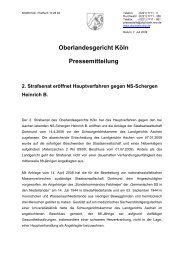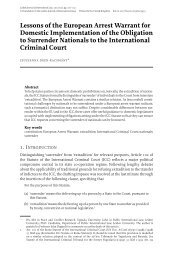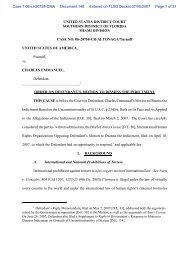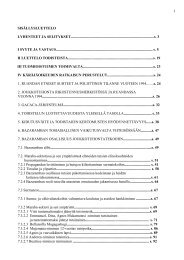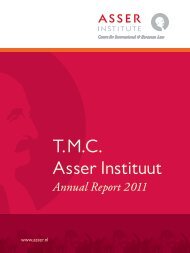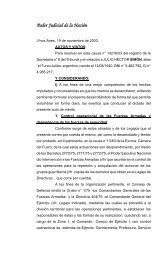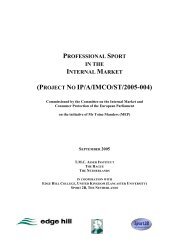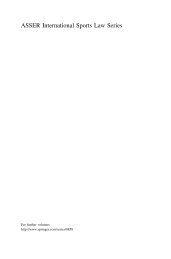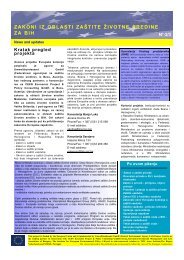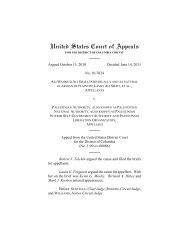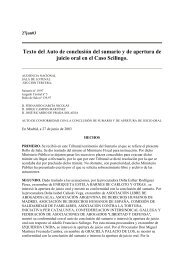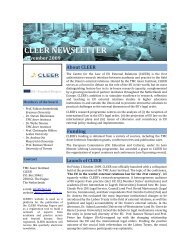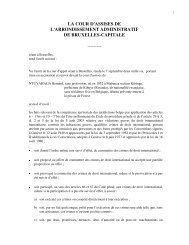potential in order to be included on the List, and the intention ofenhancing the sport performance is only discussed in the process ofdetermining if a period of ineligibility should be imposed (and if so,how long). 95. The complexity of (i) the way the Prohibited List is comprised,(ii) the application of the specified substances rule, and (iii) distinguishingbetween intentional cheating and inadvertent use, is alsoreflected in the decisions of disciplinary bodies and arbitration panelsin doping cases.a. Some disciplinary committees will focus only on the List. In arecent case, a Spanish football (soccer) player was suspended fortwo years, despite the fact that the substance at hand (finasteride)was declared a specified substance by the time the decision was rendered.In similar cases, disciplinary committees took this change instatus concerning finasteride into account by taking a more lenientapproach to this kind of positive cases.b. In various cases the panels have placed the fact that the athlete violatedthe rules at the centre of their deliberations, also in case ofspecified substances. Even though there was no intention toenhance the sport performance, the deliberate use of a prohibitedsubstance justified the imposition of a period of ineligibility,according to these panels.c. Possibly depending on the background of the members of the disciplinarycommittee panel, the focus of the decision can in somecases almost solely be on the question whether any performanceenhancement was intended. In these cases, athletes have thenreceived a warning and a reprimand for a positive test involving aspecified substances like cannabis, sometimes without actually havingto establish on a balance of probabilities that their use was notintended to gain a performance advantage. A mere statement thatthey used the substance at a party was sufficient.d. Panels often wrestle with the issue of how to ‘classify’ an athletewho has tested positive, because it is so difficult to establish theexact circumstances of a specific case. This can especially be thecase when athletes test positive for substances that are not expresslymentioned on the Prohibited List. 106. As explained in paragraph II.1, according to the Code no such thingas a by-catch exists. The Code does not differentiate between variouskinds of cheats. All adverse analytical findings are intended and shouldbe treated (persecuted) as legitimate anti-doping rule violations. If onelooks at how the rules are interpreted and applied, it becomes clear thatin the view of many hearing panels there actually is a phenomenonthat can be called a “by catch”, even though panels hesitate to go intothis kind of deliberation. Here is an example of how a CAS panels triesto come to grips with a case it considers a by-catch:“But the problem with any “one size fits all” solution is that there areinevitably going to be instances in which the one size does not fit all...Itis argued by some that this is an inevitable result of the need to wage aremorseless war against doping in sport, and that in any war there willbe the occasional innocent victim”. 11WADA obviously does not want to create or contribute to a discussionwhether some substances or some cases involving inadvertentuse, should be considered a by-catch in the fight against doping insports. Considering the lack of consensus concerning the ProhibitedList, it will not be possible to define which substances or cases shouldbe called by-catch. And since WADA and the Code have been establishedto achieve harmonization in the field of anti-doping policies,any formal approach towards formulating which doping cases constitutea possible by-catch is out of the question.7. The inability to reach an agreement on which substances shouldbe considered more important or more serious as doping agents, hasled to the situation that all substances and methods should in principlebe treated the same. It is our belief that this is exactly why WADAretained the rule that the in-competition detection of any substanceor method in connection with a competition leads to the automaticdisqualification of all individual results obtained in said competition,also in case of a specified substance violation where the athlete establishedthat he did not intend to enhance his sport performance.8. The inability to get a clear read on which athletes are “intentionalcheaters” and which athletes are “innocent victims” has created thestrict liability rule. As far as establishing an anti-doping rule violationis concerned the strict liability rule has not been the subject of discussion,at least not among anti-doping organizations. However, WADAhas sought to increase the focus on distinguishing between the differentkinds of cheaters by:a. Remodelling the specified substances rule;b. Widening the scope of application of this rule to more substances;c. Applying the no (significant) fault or negligence to all anti-dopingrule violations except article 2.4; 12 andd. The new article on aggravating circumstances (article 10.6 of the2009 Code).9. An area that has not been addressed in the 2009 Code is the testresult management and persecution of cases where (i) because of thecircumstances, such as the substance involved or the timing of theadverse analytical finding, it (ii) is unlikely that any period of ineligibilitywill be imposed. These kind of cases may under the 2009 Codestill be treated the same way as cases involving steroid or EPO users.Despite their likely outcome, these cases will still have to go throughthe entire test result management process and hearing process (includingpublic disclosure) at a significant expense: Possibly disproportionateimpact for the athlete, as well as claiming a significant amount ofanti-doping organization’s resources. Resources that many feel shouldbe directed at different areas of fight against doping.V - Additional flexibility1. The authors argue that in the 2003 Code there was not enough discretion,citing the standard two year sanction and the lack of defenceoptions for the athlete, as the main culprits. Even though there istruth in this statement, little or no complaints were ever made regardingthe discretion that this version of the Code allowed in sanctioningthe use of specified substances. As mentioned before, the majorityof positive tests involve specified substances, which according tothe 2003 Code “are particularly susceptible to unintentional anti-dopingrule violations because of their general availability in medicinal productsor which are less likely to be abused as doping agents”. The 2003 Codealso mentions the term ‘inadvertent use’ in this context. 132. The authors explain that the effect of the changes in the Code isthat “for many substances there will be a discretion that can be applied asto achieve an appropriate sanction”. With “many substances” the authorsrefer to the increase in the number of specified substances. Since the2003 Code already contains a system concerning specified substancesthat provides substantial discretion, it would have been more accurateif the authors had stated that the 2009 Code does not increase the discretionitself, but applies this discretion to a significantly increasedamount of prohibited substances.3. The authors do not include the important clarification that the2009 Code has actually introduced additional criteria for the reductionof a sanction for the use of a specified substance, which will quitepossibly make it more difficult for athletes to see the period of ineligibilityreduced.4. Since WADA was not satisfied with the ‘liberal’ manner in whichsome disciplinary bodies applied the specified substances rule, somenew elements are introduced in the 2009 Code. The 2003 Code’s onlyrequirement to get the standard two year sanction reduced in case ofa specified substance, is that the athlete has to establish “that the useof such a substance was not intended to enhance sport performance”. The2009 Code introduces two additional provisions:8 This is the header of article 10.4 of the2009 Code.9 This discretion only applies to specifiedsubstances.10 For instance: CAS 2005/A/726 CalleWilliams v/IOC, CAS 2005/A/834Dubin, ÖsterreichischerBehindertensportverband & AustrianParalympic Committee v/IPC.11 CAS 2006/A/1025 Mariano Puerta v/ITF(consideration 11.7.18).12 Article 2.4 of the 2009 Code concernsthe failure to file required whereaboutsinformation and missed tests.13 2003 Code article 10.3, including thecomment.44 <strong>2008</strong>/1-2ARTICLES
a. “The athlete has to establish how the specified substance entered hisbody”; andb. “The athlete’s degree of fault shall be the criteria considered in assessingany reduction of the period of ineligibility”. 14Ad a: WADA felt that athletes could often get away with making littleor no statements about their positive test, and thus leaving disciplinarybodies (i) in the blind about what actually happened regardingthe ingestion of the specified substance, and thereby (ii) in a difficultsituation concerning the evaluation of the facts (i.e. establishingwhether or not there was any intention to enhance the sport performance).In the 2009 Code, WADA has decided to put more pressure onthe athletes (and other persons accused of committing an anti-dopingrule violation) by introducing this new element to article 10.4, andeven more by introducing the new article 3.2.4. 15Ad b: The second new element was introduced to emphasize thecaution that should be applied by every professional or elite athlete.This caution has been described in various CAS decisions (mostlyconcerning the use of nutritional supplements), and the new Codehas translated this in the standard phrase “the expected standard ofbehavior”. 16Both additional provisions may prove to be significant hurdles forthe athlete.5. Especially in a case of contaminated nutritional supplements ora case concerning a recreational drug, athletes will face an uphill battlewhen trying to establish the source of their adverse analytical finding.In these cases an athlete may not be able to offer any more evidencethan his own word or statement. 17 The ensuing question then iswhether the athlete has established how the substance entered hisbody in the view of the hearing body. This will depend on how thehearing body interprets article 3.1 of the Code on burdens and standardsof proof. Regarding establishing how the specified substanceentered an athletes body, article 3.1 requires the proof on a balance ofprobabilities. 18 Nonetheless, hearing bodies may have varying opinionson how an athlete should fulfil his burden of proof. An interestingexample of this is the second Mariano Puerta case 19 , even thoughthat did not involve a substance that was specified at the time. In thefirst instance, the ITF tribunal ruled that Puerta did not meet therequirements of proof, and therefore ruled that he had not establishedhow the substance entered his body. Consequently, the tribunal couldnot apply the “no (significant) fault or negligence rule”. 20 However, inthe appeal before CAS, the panel found that Puerta had in fact, on abalance of probability, established how the substance entered hisbody. 21 This was a key factor in the reduced sanction that was ultimatelyimposed.6. The trick concerning the application of the reduction of sanctionsin cases of the use (presence) or possession of specified substances,is that if an athlete cannot establish how the substanceentered his body (obviously a situation that is by no means far fetchedwhen contaminated nutritional substances or so called party-drugs areinvolved), the ‘specified substance regime’ does not apply, and insteadthe standard two year period of ineligibility will be imposed. 22 Inshort, whether or not an athlete has any chance of successfully callingupon the option of the reduction of the standard two year sanction,will often depend on whether the disciplinary body is willing tobelieve the athlete’s (side of the) story.The 2009 Code makes a special point of noting that specified substances“are not necessarily less serious agents for purposes of sports doping...for that reason, an Athlete who does not meet the criteria under thisArticle would receive a two-year period of Ineligibility and could receiveup to a four-year period of Ineligibility under Article 10.6”. 23 This lastpoint presents a rather scary scenario for athletes who cannot provideevidence regarding the origin of their positive test.7. After the athlete has established the source of the adverse analyticalfinding, as well as the fact that he did not intend to gain a performanceadvantage, “the athlete’s or other persons degree of fault shallthen be the criteria considered in assessing any reduction of the period ofineligibility”. 24The wording “any reduction” suggests a restrictive application ofany sanction reduction under article 10.4 of the 2009 Code. Combinethis with the increase of the maximum ineligibility period in case of afirst offence from one to two years, and one could wonder whetherthe position of the athlete has improved all that much. After all, byestablishing how the prohibited substance entered his body, the athletewill in all likelihood admit to acting with some degree of fault. Itis even possible that tribunals - from 2009 on - will impose periods ofineligibility that are closer to the one year period that has more or lessbecome the standard for doping cases not involving specified substancesin cases where the athlete established that he acted withoutsignificant fault or negligence (where at the moment, sanctions forspecified substances are more in the warning to two month ineligibilityrange).8. Regarding additional discretion in the 2009 Code when nonspecifiedsubstances are involved, the conclusion is that the increasedflexibility in part is attributable to applying the existing options fordiscretion to more anti-doping rule violations.The existing system itself increases flexibility by expanding thereduction for substantial assistance, and including the possibility ofreduction in case of a (timely) admission by the athlete. Importantnote: The article that has been applied the most in case of any reduction(article 10.5.2: No significant fault or negligence) has in fact notbeen changed.9. The question can be asked whether the “morally innocent athlete”,as described by the authors, is better off in the 2009 Code. Werefer here to the CAS decision involving the American athlete TorriEdwards. 25 This case involved one isolated case of inadvertent use inwhich the athlete undeniably was negligent, although with very innocentand limited (if any) consequences as far as unfair competitiveadvantage is concerned. The panel argued in her case that it was “satisfiedthat she (Edwards) has conducted herself with honesty, integrity andcharacter and that she has not sought to gain any improper advantage orto “cheat” in any way”. This conclusion did not help Edwards, whoreceived a two year suspension. As far as non-specified substances areconcerned, the improved discretion under the 2009 Code will nothelp an athlete in a case like Torri Edwards, hence such an outcomewill still be possible.10. The fact that in the past as well as the present, several disciplinarybodies (mostly on the national level) have not applied the rulesproperly, has contributed to the current setting, where the Code doesnot allow the disciplinary bodies the discretion they could or perhapsshould have. Due to the amount of decisions with an outcome thatwas not Code-compliant, WADA has felt it was necessary - also in the2009 Code - to limit the discretion by establishing fixed or minimumsanctions, and to install some boundaries for evaluating and weighingexceptional circumstances. The side effect of these restrictions can be14 Under the 2003 Code, some panels haveused the degree of fault or negligence as acriterion, others have not.15 Which allows a tribunal to draw an inferenceadverse to the athlete or other personin case that athlete or person refusesto appear at a hearing and refuses toanswer questions from the tribunal oranti-doping organization.16 See the comments to article 10.4 and10.5.17 WADA accredited laboratories do notusually analyse supplements for athleteswho are involved in a doping case.Moreover, labs will need an unopenedsupplement from the same productionbatch in order to make any reliable kindof statement about contamination.Athletes usually cannot meet theserequirements. When party-drugs areinvolved, athletes may not be able to findany (reliable) witnesses of their drug use.18 See the comment to article 10.4 of the2009 Code.19 In 2003 tennis player Mariano Puertatested positive for clenbuterol. In 2005,Puerta tested positive for etilefrine.20 Article 10.5 of the Code is only applicablein cases where the athlete can establishhow the substance entered his body.21 CAS 2006/A/1025 Mariano Puerta v/ITF(consideration 11.3.8).22 Unless the athlete can establish that therewas no (significant) fault or negligenceon his part, which (if one looks at CAScase law) will be difficult when the athletesattributes his positive finding toeither contaminated nutritional supplementsor party-drugs. It is important tonote here that 10.5 only applies to specifiedsubstances when 10.4 does not apply(see comment to article 10.5). Hence,articles 10.4 and 10.5 cannot be applied atthe same time to a case involving specifiedsubstances.23 Comment to article 10.4.24 Article 10.4 of the 2009 Code.25 CAS arbitration N° CAS OG 04/003.ARTICLES<strong>2008</strong>/1-2 45
- Page 6 and 7: White Paper has been prepared meets
- Page 8: and the Commission in particular. T
- Page 11 and 12: The EU Commission’s White Paper o
- Page 13 and 14: of the sport structure 21 ) will co
- Page 15 and 16: choosing a political and non-bindin
- Page 17 and 18: law of the country concerned, the s
- Page 20 and 21: 16 of the FIFA Status Regulations,
- Page 22 and 23: Be that as it may, clearly, if club
- Page 24 and 25: decide whether or not any provision
- Page 26 and 27: The Prize for Freedom of Movement:
- Page 28 and 29: observed that the extract only stip
- Page 30 and 31: not an amount Hearts had in mind. T
- Page 32 and 33: all club, the player is an active a
- Page 34 and 35: The regulations above apply if a pl
- Page 36 and 37: clubs from different football assoc
- Page 38 and 39: 04 appealed on the grounds of endin
- Page 40 and 41: (i) There is to be a new sanction f
- Page 42 and 43: H. Provisional Suspension after A S
- Page 44 and 45: 63. On the other hand, alternative
- Page 48 and 49: that capable, qualified and experie
- Page 50 and 51: X - New rights of appeal1. The auth
- Page 52 and 53: A The Debate1 The pro argumentsThe
- Page 54 and 55: fundamental rule, known as “in du
- Page 56 and 57: lete’s body, the use of a prohibi
- Page 58 and 59: J.Comp. & Int’l L. (Duke Journal
- Page 61 and 62: 2008/1-2 59
- Page 63 and 64: isk of loss or damage to goods in t
- Page 65 and 66: True Supporters, Strict Liability,
- Page 67 and 68: CAS points at article 6 of UEFA Dis
- Page 69: subsequent disorder that occurred w
- Page 73 and 74: private member’s bill it was fear
- Page 75 and 76: found guilty of a criminal offence?
- Page 77 and 78: From our observations, applications
- Page 79 and 80: all violence abroad is misleading,
- Page 81 and 82: presumed allowances were four times
- Page 83 and 84: of the activity, both the amateur a
- Page 85 and 86: Nations. The crown prince, Willem-A
- Page 87: 6. These consultations must be cond
- Page 91 and 92: of sport versus the “American”
- Page 93 and 94: The Position of the Players’ Agen
- Page 95 and 96: - Is there a need for regulation if
- Page 97 and 98:
Some Thoughts about the European Cl
- Page 99:
need for a solid, enforceable legal
- Page 103 and 104:
ing the appointment of members of t
- Page 105 and 106:
cedure (para. 2). Thus, in such pro
- Page 107 and 108:
elevant section of the public estab
- Page 109 and 110:
Sepp Blatter’s call to see player
- Page 111 and 112:
And the ‘White Paper’ adds that
- Page 113 and 114:
The EASE President Marie Leroux is
- Page 115 and 116:
Report on the Conference “Sport a
- Page 117 and 118:
Sports Law Conference in South Afri
- Page 119 and 120:
The Jurisprudence of the FIFADisput
- Page 121 and 122:
EU Competition Law. The European Co
- Page 123 and 124:
The Sports Boycott of Nigeria: Spor
- Page 125 and 126:
case France). France too, however,
- Page 127 and 128:
10:40 Coffee break11:00 The Sportin
- Page 129 and 130:
2008/1-2 127
- Page 131 and 132:
from 19 July to 4 August 1996, and
- Page 133 and 134:
sion the item entitled “Building
- Page 135 and 136:
Publication of CAS Awards(per March
- Page 137 and 138:
on June 21, 2002 cannot be consider
- Page 139 and 140:
contract had not been terminated, w
- Page 141 and 142:
Employment Contract signed with Gua
- Page 143 and 144:
FIFA Disciplinary Committee and thu
- Page 145 and 146:
By letter dated 27 July 2005 the Re
- Page 147 and 148:
National Anti-Doping Agency at the
- Page 149 and 150:
In its written decision, the Panel
- Page 151 and 152:
the Club had breached the Contracts
- Page 153 and 154:
1. right to promptly request an ana
- Page 155:
“TRANSLATING IS THINKINGWITH ANOT



